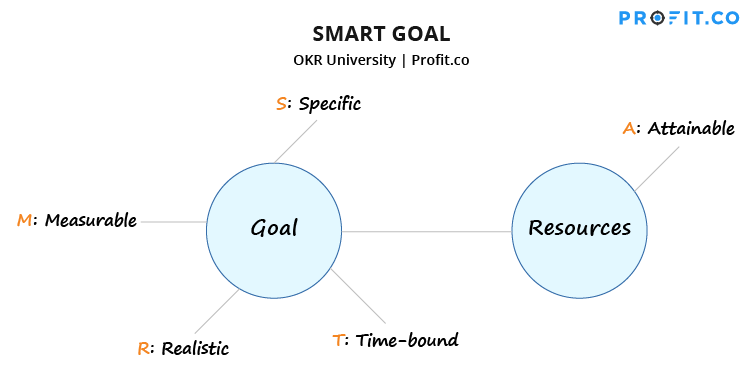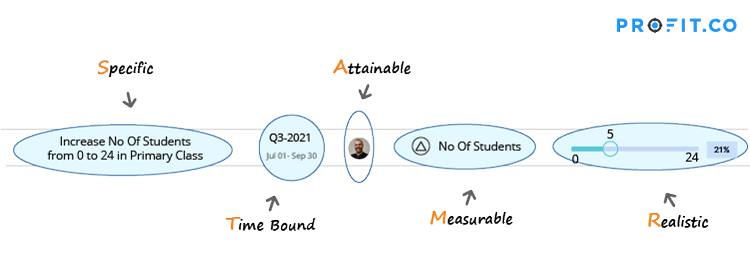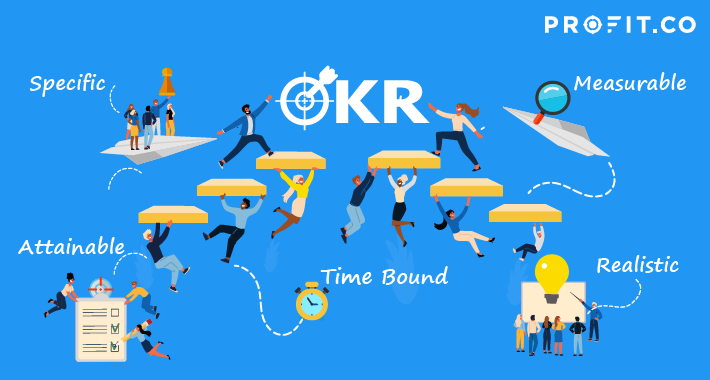Setting goals is the first step in turning the invisible into the visible.
SMART Goals
Let’s take a closer look at each requirement of a SMART goal.
- S: Specific: The target is unambiguous for everyone to see.
- M: Measurable: The target’s progress can be measured.
- A: Attainable: There are enough people and resources to achieve the target.
- R: Realistic: The target is not impossible to achieve.
- T: Time-bound: The target has a strict, clear deadline.
Making your goal specific means that there should be no ambiguity about the topic or extent of your goal. Anyone reading it should be able to tell what your goal is, precisely. For example, if you have a goal to grow annual recurring revenue (ARR), you should not simply write your goal as: “Grow ARR”. Instead, you should provide a specific number. For example, “Grow ARR to $4M”. M– Measurable
Ensuring that your goal is measurable is an important part of staying on track each and every week. You will not be able to determine when you achieve your goal if you cannot measure it. So, when setting a goal, you should specify what you are measuring– such as the number of leads, or number of conversions. It’s a good idea to use your department or team’s important KPIs to get an accurate idea of how your goal is progressing. On a weekly basis, you can count your progress and track your progress towards your goal. A– Attainable
When you set goals, they should always be attainable with what your team, department, or organization has on hand. This attribute speaks towards the capacity of your employees and capability of resources that you have available in your organization at this point. If you have a goal that is specific and measurable, but you don’t have any employees available to work on it, or don’t have the budget to execute it, then the goal isn’t useful– and it won’t succeed. R– Realistic
While the attributes “attainable” and “realistic” may sound like synonyms, they address unique characteristics of a goal. While the achievability of a goal refers to how attainable it is with the resources of the organization, the attribute “realistic” refers to the target itself. Has the department or team assigned to this goal completed something like this in the past? Will they have a tried and true method to achieve this target? Or are they starting from scratch? Is there a precedent that can tell your team this target is realistic for them? T– Time-bound
Finally, you need to ensure that your goal has a distinct deadline that adds urgency and importance to the target. While you might have a goal to revamp your marketing materials, very little will be accomplished if you do not have a deadline to prompt yourself and others to get moving on what needs to be done. Goals should meet all of the requirements outlined by the SMART acronym. These characteristics build on one another to create a solid goal that is informative, unambiguous, time-bound, and measurable. If you meet all of these attributes, you’ll have a solid, well-structured goal. If you want an agile OKR software that helps you write strong OKRs and maintain transparency and alignment all quarter long, sign up for Profit.co’s OKR software free today!
Key Results
Key results are the quantitative outcomes that help measure the success of objectives in your OKR program. Many OKR champions report struggling with learning to write solid, well-structured key results in the early stages of their OKR program– SMART goals can actually help with this. Let’s take a look at a high-quality key result: Increase the number of students enrolled in primary class from 0 to 24 in Q3.




